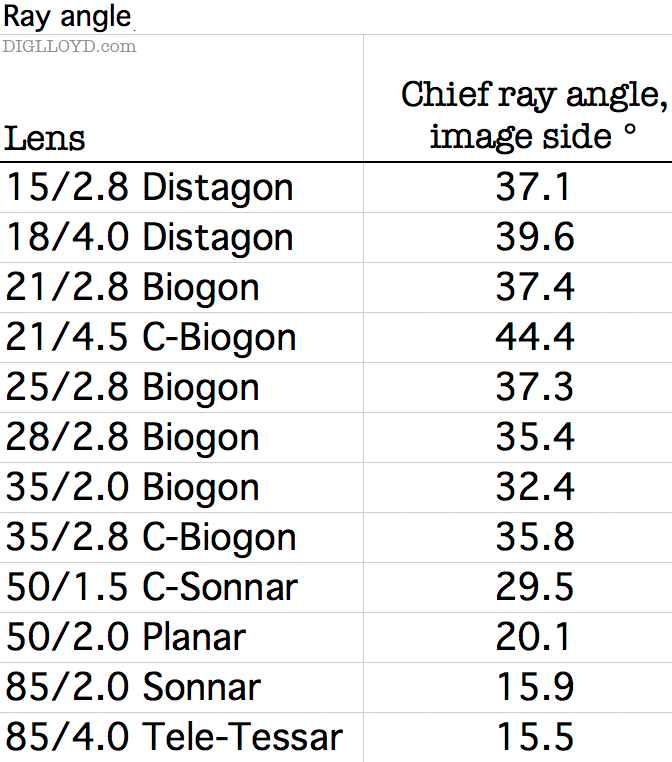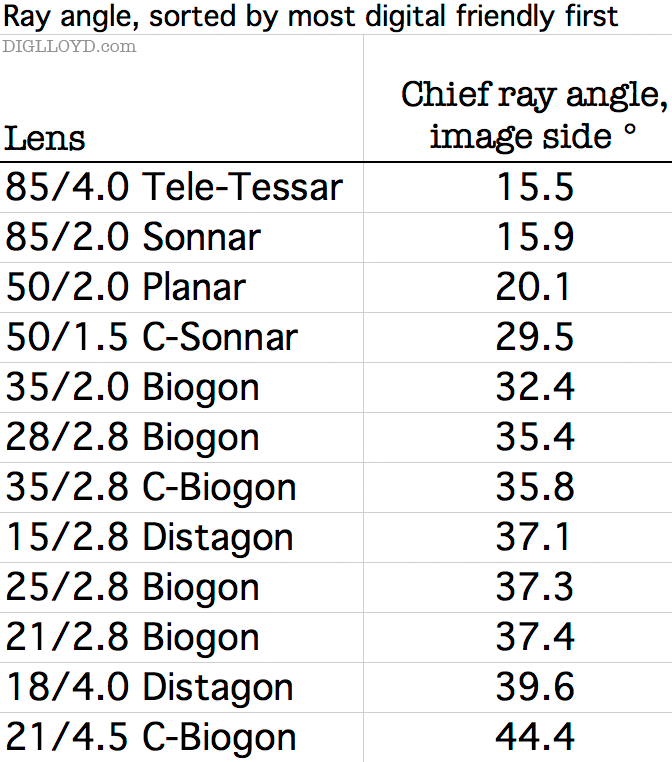EXCERPT page containing first few paragraphs. 2024-04-24 16:10:22
UA_SEARCH_BOT_compatible_botmozilla/5.0 applewebkit/537.36 (khtml, like gecko; compatible; claudebot/1.0; +claudebot@anthropic.com) @ 3.136.22.50
For full access, subscribe here. Or click title to login. ![]()
Ray Angles for Rangefinder Lenses
Ray angle are to the corner of a full-frame 35mm sensor.
Ray angles are much steeper (unfriendly) for rangefinder lenses than ray angles for DSLR lenses; A “steep” digital-unfriendly ray angle is 30° or more, a figure approached or exceeded by many rangefinder lenses.
For the best color shading and sharpness, a more perpendicular (smaller) ray angle is desirable. The following generalizations are found to hold for all the Zeiss ZM rangefinder lenses. Leica M lenses will behave similarly:
- A chief ray angle of 25° or less generally can be considered excellent with little or no concern for performance issues (only minor color shading and minimal loss of sharpness at the edges/corners).
- A chief ray angle of 26° - 35° can be quite acceptable or marginal according to the sensor type (acceptance angle).
- A chief ray angle of 36° or greater shows negative effects including significant to strong color shading and moderate to strong loss of sharpness at the edges/corners.
Article continues for subscribers...
Diglloyd Making Sharp Images is by yearly subscription. Subscribe now for about 13 cents a day ($50/year).
BEST DEAL: get full access to ALL 8 PUBLICATIONS for only about 75 cents a day!
Diglloyd Making Sharp Images articulates years of best practices and how-to, painstakingly learned over a decade of camera and lens evaluation.
Save yourself those years of trial and error by jump-starting your photographic technical execution when making the image. The best lens or camera is handicapped if the photographer fails to master perfect shot discipline. High-resolution digital cameras are unforgiving of errors, at least if one wants the best possible results.
- Eases into photographic challenges with an introductory section.
- Covers aspects of digital sensor technology that relate to getting the best image quality.
- Technique section discusses every aspect of making a sharp image handheld or on a tripod.
- Depth of field and how to bypass depth of field limitations via focus stacking.
- Optical aberrations: what they are, what they look like, and what to do about them.
- MTF, field curvature, focus shift: insight into the limitations of lab tests and why imaging performance is far more complex than it appears.
- Optical aberrations: what they are, what they look like, and what to do about them.
- How to test a lens for a “bad sample”.
Intrigued? See Focusing Zeiss DSLR Lenses For Peak Performance, PART ONE: The Challenges, or (one topic of many) field curvature.



